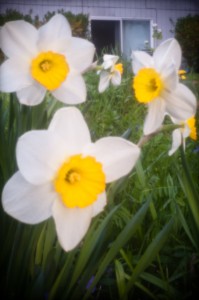 |
 |
Well I hope you polished off your pinholes and had some fun this weekend! The last Sunday of every April marks World Wide Pinhole Day. People from all over the world take a step back and use a handmade pinhole camera or converted digital camera to create amazing images.
This year’s online gallery is already starting to populate so check out it out!
My film shots are still waiting to be dropped off at the lab tomorrow, but I did take my Lensbaby ZonePlate/Pinhole lens for a walk with my D700 camera. In the two shots of the daffodils I wanted to show the difference between the soft focus glow of the zone plate and the soft sharpness of the pinhole. The beauty of the Lensbaby dual optic is the ease that you can switch between Zone and Pinhole mode. This $35 optic will definitely make you see in a new way with your Lensbaby. The Zone Plate is a permanent f/19 and the Pinhole is f/177, both settings make it dim to look through the viewfinder of your SLR camera. I find it easier to compose by putting my camera in Live View mode, which shows the “live” image on the back of the screen. In a sunny environment the Zone Plate is easy to compose this way. Take a test shot, if you like it ~ why not shoot it again with the pinhole setting? I advise using a tripod if possible. The Zone Plate is easy to use handheld on a sunny day but the pinhole will have 2-10 second exposures on a bright day. Remember the Pinhole setting needs about 5 more stops of light to get the equivalent exposure.
Don’t feel like counting the math of 5 stops? Here is a little reciprocity math trick:
I call it the Six Stop Rule:
If your Zone Plate Exposure equals 1/10 of a second exposure
Change your Pinhole to a 10 second exposure, which would be 6 stops difference, then half that number (subtract a stop) which would be 5 seconds and the equivalent of 5 stops.
Let’s try it again:
Zoneplate Exposure equals 10 seconds. To add each stop of light you need to multiply by 2.
20 seconds = 1 stop
40 seconds = 2 stops
80 seconds = 3 stops
160 seconds = 4 stops
320 seconds = 5 stops
320 seconds = 5 1/2 minutes. The difference between 5 and 5.5 minutes at such a long exposure is negligible.
You can use the “Six Stop Rule” easily to compute the switch from zone plate to pinhole with the Lensbaby optic.
Tens of seconds = Seconds (minus a stop) – 1/8 second = 4 seconds
Seconds = Minutes (minus a stop) – 15 seconds = 7.5 minutes
Minutes = Hours (minus a stop) – 2 minutes = 1 hour
I’ll be teaching more about the Fine Art of the Long Exposure at a FREE seminar at B&H Photo on May 27th from 11am-1pm. Feel free to bring by any pinhole or night images for feedback, and if you shot any pinhole on World Wide Pinhole Day, upload them to their site!
Hope to see you there.
Thanks for the tip regarding your pictures of the dafodils. As soon as I buy the lens I will try it on a couple of subjects. Can you put me on your mailing list for any future Webinars?
Thanks for sharing. I have the ZonePlate/Pinhole lens and have had a hard time metering for the pinhole exposure, so this will come in handy. I’ll have to go try it out!